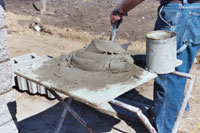Hot weather poses a few challenges for masonry construction. As ambient temperatures rise, and materials and equipment heat up, moisture evaporates more rapidly, leaving less water available for cement hydration.
 Adding water to and remixing fresh mortar is called “retempering” and is considered good masonry practice.
Adding water to and remixing fresh mortar is called “retempering” and is considered good masonry practice.
This article outlines ten recognized techniques to overcome the negative effects of hot weather on masonry construction.
For masonry construction, hot weather is defined as “ambient temperature exceeding 100 degrees Fahrenheit, or 90 degrees Fahrenheit when the wind velocity is greater than 8 mph.” Compounding factors include low relative humidity and direct sunshine. As the temperature of mortar increases:
- Workability is reduced
- More water is required to maintain a given workability
- A given amount of air-entraining agent yields less entrained air
- Initial and final set occur earlier, and evaporation rates are generally faster
- Units absorb more moisture from the mortar
As a result, the mason will find it more difficult to place mortar and units. In addition to effects on workability, rapid drying can result in a lack of sufficient water for hydration of cement in the mortar. Inadequate hydration can affect normal strength development of mortar, leading to a reduction in strength. Exposed mortar surfaces are particularly vulnerable. Evaporation removes moisture more rapidly from the outer surface of a mortar joint.
Selecting a Mortar Mix for Hot Weather
In hot-weather construction, mortar properties such as water retentivity and workability should be given careful consideration when selecting ingredients and mortar type. For example, provided Type N and Type S mortars are both structurally adequate for a given masonry application, the increased water retentivity and workability generally associated with a Type N mortar make it a better choice for construction during hot weather. Ten techniques that can be used for construction of masonry in hot weather include:
- Select workable, water-retentive mortar mixes (see above)
- Schedule construction to avoid hot, midday periods
- Minimize exposure of materials and equipment to direct sunlight
- Use cool water to mix mortar
- Maintain sand piles in damp, loose condition
- Flush metal equipment and wooden mortar boards with cool water before contact with fresh mortar
- Pre-wet clay masonry units if they have high absorption, high initial rate of absorption (IRA)
- Don’t spread mortar too far ahead of work
- Place upper units on mortar bed as quickly as possible
- Under extreme drying conditions, use windbreaks, fog sprays, or wall coverings to assure adequate moisture for curing of mortar
Related Publication
Hot Weather Masonry Construction, IS243